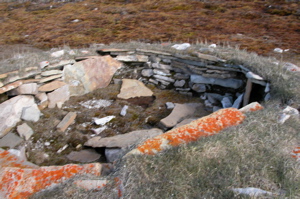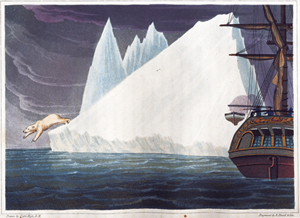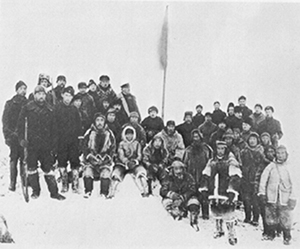
History
Sirmilik National Park
Pre-Contact History

Archaeological research indicates that the earliest people on Baffin Island were from the Pre-Dorset and Dorset cultures dating back more than three thousand years from about 1700 B.C. to A.D.1000. The ancestors of these people are believed to have originated in the Bering Strait region of Alaska prior to migrating across the Canadian arctic and into Greenland, from west to east.
A second wave of migration from Alaska resulted in the arrival of Thule people into the eastern arctic around the end of the 11th century, about a thousand years ago. While Inuit oral history and ethnographic accounts often refer to the Dorset as ‘Tunit’, it is not known to what extent the Thule displaced or potentially intermixed with the Dorset. Over time the Dorset culture disappeared, and by A.D. 1200 the Thule culture was predominant. Modern Inuit are direct descendants of the Thule people.
While remains of Paleoeskimo (Pre-Dorset and Dorset) cultures represent the earliest human occupations in within the park region, they represent only a small portion of the documented archaeological sites and Thule / Inuit sites make up the majority of documented archaeological sites within the park. This may be in large part be because Thule/Inuit sites often appear to have been built in the same locations as Paleoeskimo sites and Thule/Inuit occupations may have been more intense, resulting in more features on the ground. The park encompasses a large area and the subtle traces of Paleoeskimo cultures require more intensive investigations.
The Thule way of life was highly adapted to a coastal marine and tundra environment. With dogs, sleds, umiaqs (large skin boats), and qajaqs (kayaks), the Thule people were highly mobile hunters of land and sea animals. Seasonal activities were dictated by the abundance and distribution of the hunted species.
Seals, especially ringed seals, were their main source of food and were hunted year-round. Caribou were also hunted year-round, and the skins used to make clothing for the winter. Fish were important in the summer months, and in the spring ice fishing and waterfowl hunting added variety to their diet. Bowhead whales and narwhals were also prized and hunted, and there is some evidence that walruses were hunted as well.
Thule people usually used the same winter settlements year after year. Early Thule winter houses were built with sod, stone, and whalebone. The roofs were built with whale ribs and covered with skins and sod. The inside of the dwelling would be slightly below ground level, with a tunnel from the outside leading in. The rear of the dwelling would contain a sleeping platform with small storage compartments underneath. Side platforms would hold the seal-oil lamps and would serve as tables for cooking and drying clothes.
Over the centuries there were some variations in the Thule lifestyle in response to environmental conditions. For example, a cold climatic episode dubbed the “little ice age” occurred over a period of about 400 years, affecting the hunting patterns of the Thule people and forcing them to become more nomadic and to disperse. Despite the environmental changes, the Thule culture persisted until the period of earliest contact with Europeans, a period that also coincided with the end of the “little ice age”. The transition from Thule to Inuit culture occurred between 1600 and 1850.
Archaeological sites in the Sirmilik region have been documented throughout Eclipse Sound, Navy Board Inlet and Bylot Island and other areas of the park. A number of sites are concentrated around Button Point at the southeast tip of Bylot Island, as this site is close to a polynya, where there is open water year-round, and good opportunities for hunting marine mammals.
Post-Contact History

The first recorded visit by Europeans to Baffin Island was made by captains Robert Bylot and William Baffin when they entered Jones Sound and Lancaster Sound in 1616. In 1818, explorers Sir John Ross and Sir William Edward Perry also passed through the area while searching for the Northwest Passage. Starting around the 1820's, British whaling fleets began to penetrate the area in search of bowhead whales. As trading began with whalers and explorers, items such as rifles, tobacco, and tea were introduced, and the Inuit culture began to change. Seasonal hunting continued, but patterns changed to accommodate the whaling season as many Inuit were employed by the whalers. The whaling industry remained active in the region for the next half century, and Bylot Island became one of the most active northern whaling grounds.
The Twentieth Century
Bylot Island

In 1906, J.E.Bernier sailed into Eclipse Sound and took possession of Bylot Island on behalf of Canada. While the diversity and richness of the bird population had been recognized for some time, it wasn't until the late 1950's that formal studies began. In 1965, Bylot Island was designated by the federal government as a Migratory Bird Sanctuary. More avian studies were conducted on the island in the 1970's. In 1988, a seasonal research camp was established on Bylot Island by the Canadian Wildlife Service and the University of Laval in Quebec. Their original intent was to study the ecology of the Greater Snow Goose population, but over time the scope of the work expanded to include the monitoring of other species such as arctic foxes, lemmings, snowy owls, and Lapland longspurs. Field studies and monitoring continue on an annual basis.
Pond Inlet

In 1912, explorers arrived in the Pond Inlet region looking for gold. They weren't successful in finding gold, but they did open some small trading posts, making Pond Inlet a gathering point for trade. The Hudson's Bay Company arrived in 1921. By 1929, Anglican and Catholic church missions had been established, as well as the RCMP.
Most Inuit continued to live off the land until the 1960's, when their children were first required by the federal government to attend school. A school and student residences were constructed in Pond Inlet, and most of the families eventually moved into the settlement to be closer to their children. Today, Pond Inlet has a population of around 1600 and was the first community in Nunavut to have its school fully staffed by Inuit educators.
- Date modified :